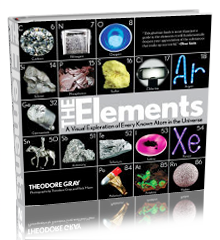Radon generating thorium oxide. | |||
| Sample Image | |||
| Radon generating thorium oxide. The longest-lived isotope of radon has a half-life of only 3.8 days, which means you can't really collect and store a sample of radon: It would be completely gone within a few weeks. But you can seal up some thorium oxide in a glass tube and be sure you always have some. Radon is one of the decay products of thorium, and there will always be some radon gas trapped in the tube. The concentration should be fairly constant, because thorium has a very long half-life while radon has a very short one: There should by now exist in this tube an equilibrium concentration of radon, which perhaps some helpful reader will calculate for me (necessary information: ca. 0.5g of thorium oxide in ca. 0.5cc volume tube). The source of this tube, Gillian Pearce, reports that thorium oxide is a better source of radon than is pure thorium metal (which I have much more of), because the radon can't escape from the metal and remains trapped there as it decays. Mike Seifert, a graduate student in Physics at the University of Chicago, wrote to me with a calculation of how much radon he thinks is in my tube: Since you asked on your radon page: by my calculations, you have about 5.2 * 10^-17 grams of radon in your tube of thorium oxide. The source of this number is essentially (after a moderate amount of math): Source: eBay seller rubbleshop Contributor: eBay seller rubbleshop Acquired: 19 October, 2002 Price: Donated Size: 1" Purity: <1% | |||
|

